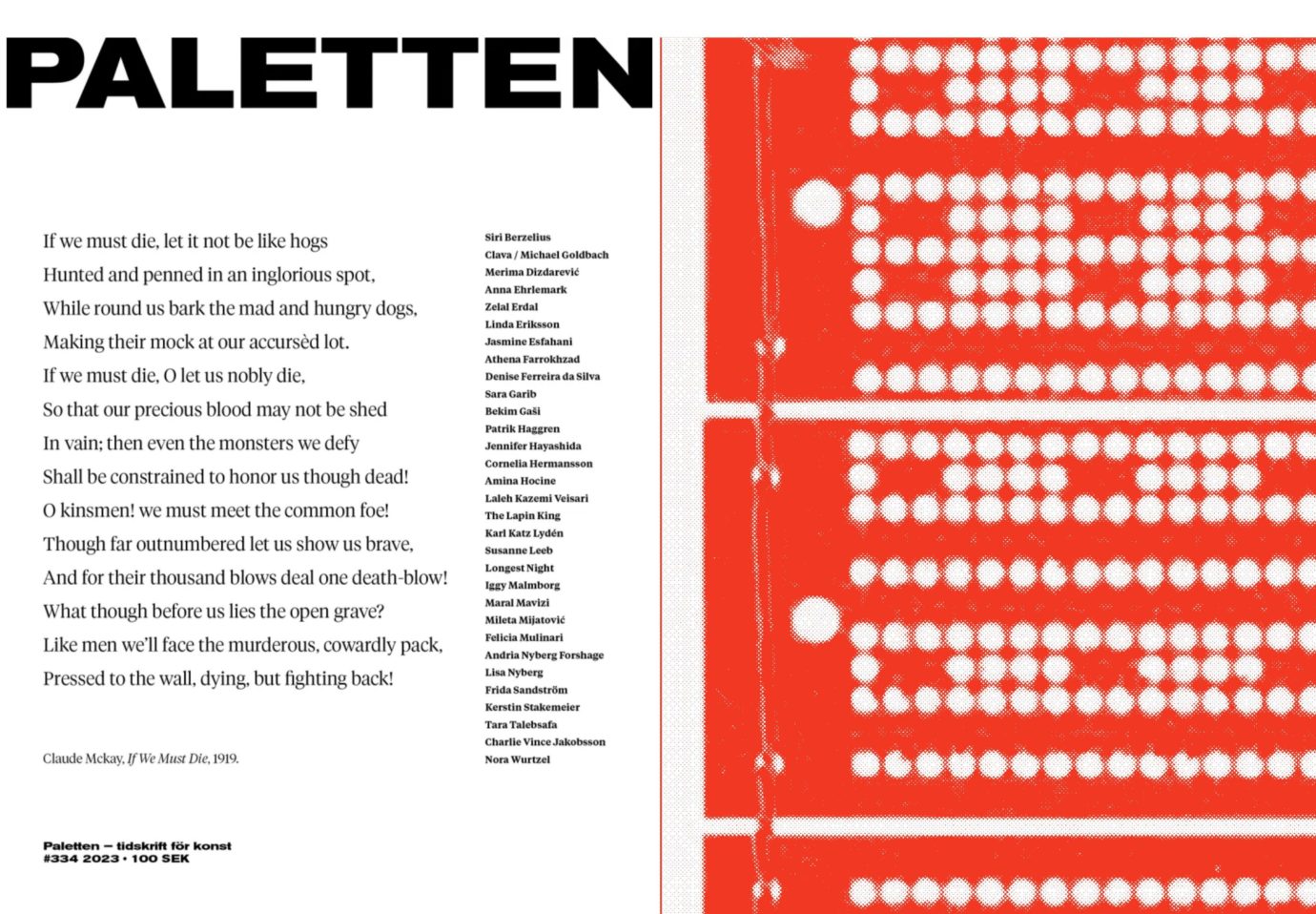Looms and Language: Stacey de Voe X Paletten Art Journal

Looms and Language: Stacey de Voe X Paletten Art Journal
Artist talk and double publication release
Friday 15 March, 18:30 – 21:00
This event will be held in English and Swedish.
Welcome to an evening where we celebrate language through the warp of the spoken word and the weft of the printed word.
Artist talk
The evening will begin with an artist talk by Stacey de Voe accompanying her current exhibition Under the Needle’s eye (24.2–31.3) which takes its starting point from a lost textile industry; Kürzel’s Factory (1896–1955) where Skånes konstförening’s premises are located. Her presentation will unravel around several recurring themes within her practice including historicity, labor, collective memory, friendship and thread politics.
Publication 〜 Under the Needle’s Eye
Following the artist talk, de Voe will introduce the publication that coexists with her exhibition. There will be readings by two of the contributing authors Ina Nian and Emil Sandström, followed by a conversation.
Paletten #334
After a brief interlude, Paletten will take the stage and introduce their latest issue. “Swedish cities are among the most segregated in Europe, but what does this mean for the critical discussion of art?” Paletten issue #334 delves into this inquiry through a collaborative editorial process. Paletten Art Journal is an artistic research based art journal that was founded in 1940.
Program
18.30: Doors open
18.45: Artist talk – Stacey de Voe
(Break)
19.30: Introduction to Stacey de Voe’s publication including readings by Ina Nian and Emil Sandström
(Break)
20.05: Introduction to Paletten #334 by editors Merima Dizdarević and Patrik Haggren. Reading by Iggy Malmborg: “Försök om skådespelarens paradox”
20.45: Mingle
21.00: The End
Stacey de Voe’s publication includes texts by Hanan Benammar, Mathias Cantzler, Makda Emabie, Helle Lindskog, Lisa Tracy Michalik, Ina Nian, Magnus Olofsson, Emil Sandström, Kuba Szreder and Kathi Weeks designed by Anders Stockman (VarvVarv).
Paletten #334
Swedish cities are among the most segregated in Europe, but what does this mean for the critical discussion of art? Daniel Terres and Patrik Haggren have asked this question through their work with Urban Konst at Göteborg Konsthall and wanted to create a space to investigate it collectively. They brought in Merima Dizdarević to mentor a group of young people with an interest in both art and power mechanisms. Thus was created Skälens tunga, a writing group that together and as individual writers discussed, read and wrote art criticism. This issue of Paletten is a collaboration where the group’s work was further extended to the editorial process, with Paletten’s editor Patrik Haggren and Merima Dizdarević joining as guest editors together with Skälens tunga. Contributors: Siri Berzelius, Clava / Michael Goldbach, Merima Dizdarević, Anna Ehrlemark, Zelal Erdal, Linda Eriksson, Jasmine Esfahani, Athena Farrokhzad, Denise Ferreira da Silva, Sara Garib, Bekim Gaši, Patrik Haggren, Jennifer Hayashida, Cornelia Hermansson, Amina Hocin, Laleh Kazemi Veisari, The Lapin King, Karl Katz Lydén, Susanne Leeb, Longest Night, Iggy Malmborg, Maral Mavizi, Mileta Mijatović, Felicia Mulinari, Andria Nyberg Forshage, Lisa Nyberg, Frida Sandström, Kerstin Stakemeier, Tara Talebsafa, Charlie Vince Jakobsson, Nora Wurtzel.
Bios
Stacey de Voe, b. 1988 – lives and works in Malmö. She works with site-specificity and the archive to investigate wider issues of historicity, labour politics, collective memory and friendship. Her works link archival material, personal narratives and fiction to evoke an awareness and understanding of our time. In her often relational process, she uses audiovisual and performative methods to stage speculative narratives. She received her Master’s degree from Malmö Art Academy in 2023.
Ina Nian, b. 1992 – is an artist based in Malmö. Nian has created a method called Black Noise that allows them to explore another side of the art world, the one that is often erased but not imperceptible, but governed by what frequency you can perceive. They use Black Noise as a guideline in their current artistic research process focusing on Sweden’s colonial iron trade history during the transatlantic slave trade. Their practice involves history, archival material and critical theory.
Emil Sandström, b. 1994 – lives and works between Malmö and Paris. His work revolves around an interest in the different economies of language and image, moving between photography, sound, sculpture and text. Through a site-specific approach, ideas of circulation and translation are addressed: the infrastructures and information flows that facilitate and govern affective exchanges, and help shape power relations between the body and architecture. Sandström received his Master’s degree from Malmö Art Academy in 2022 and was co-founder and coordinator of Canopy, an artist-run exhibition space in Malmö, 2020-22.
Merima Dizdarević was born in Yugoslavia (Bosnia and Herzegovina) and lives in Malmö. She works with writing, translation, film, performance and other artistic expressions. She has studied the Master’s programme in Literary Design at Valand Academy and made her debut with the poetry book långt från ögat – långt från hjärtat at Albert Bonniers förlag autumn 2022. In spring 2023, she supervised the course Skälens tunga.
Patrik Haggren works with the programme and urban art at Göteborgs konsthall, is a theory teacher at Gerlesborgsskolan in Bohuslän and Paletten’s deputy editor.
Iggy Malmborg is an actor and director. He has been touring his own performances in Europe for 15 years and has participated in a number of film and TV productions in Sweden. In his own performances, he generally engages in taking apart the theatre situation and critically analysing its separate elements, often using the tradition of psychoanalysis. Each piece has a specific focus. Iggy Malmborg has worked with the imagination, the voice, and vision, and in his latest production SATAN, which premiered at Schauspiel Leipzig in 2023, illusion is in the centre. Using strategies comparable to minimalism, he sheds light on the politics of the theatre situation, reading it as a hierarchical machine with inherent patterns of inclusion and exclusion.